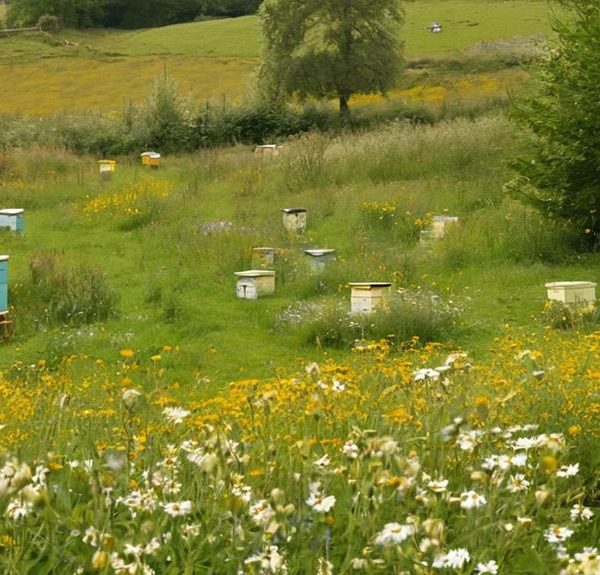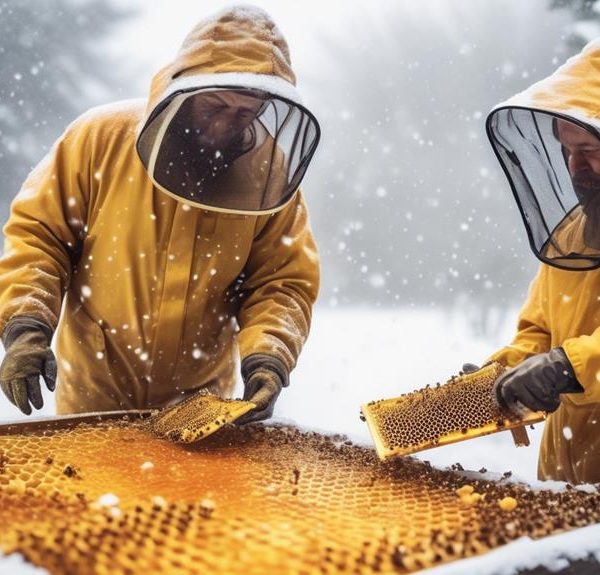Find out fascinating, eco-friendly techniques to pacify bees without smoke, and delve into the serene world of beekeeping.
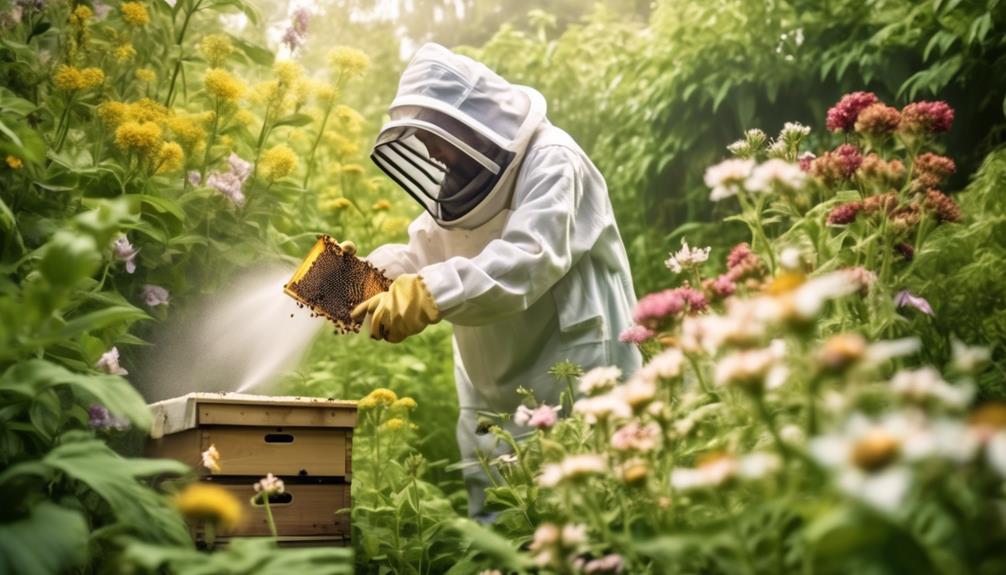
How to Calm Bees Without Smoke?
Like a Zen master seeking tranquility amidst chaos, you too can find peace when surrounded by buzzing bees. You're probably familiar with the traditional method of using smoke to pacify these industrious insects, but have you ever wondered about smokeless alternatives?
Well, it's time to uncover some lesser-known, environmentally friendly techniques to calm bees without disrupting their natural behavior or your peace of mind. Intriguing, isn't it?
But don't let your curiosity stop here; there's much more to explore in this fascinating realm of beekeeping.
Key Takeaways
- Bees can be calmed through slow and gentle movements.
- Using sugar spray or essential oils like lemongrass or lavender can help calm bees.
- Natural bee calming techniques, such as using pheromone lures or draping a wet cloth over the hive, can be effective.
- Smoke-free methods are beneficial for both the quality of honey and the overall health of the bee colony.
Understanding Bee Behavior
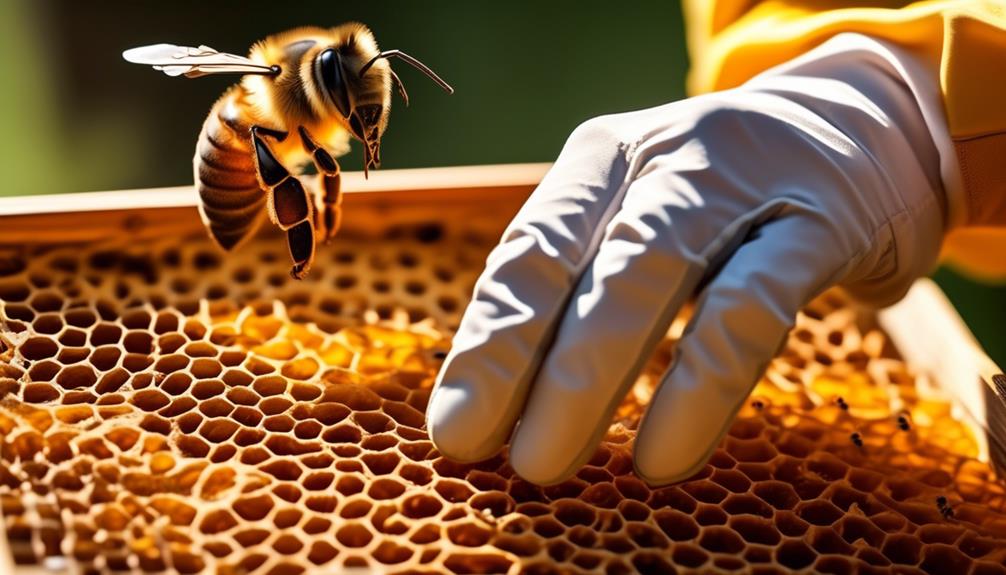
Before you can effectively calm bees without smoke, it's crucial to understand their behavior and communication patterns. Bees are complex creatures with a strong sense of community. They communicate through dances, pheromones, and physical contact, providing information about food sources, threats, and hive conditions.
Their reactions to external factors such as sound, light, and movement are important to note. Quick, jerky movements or loud noises can trigger alarm pheromones, resulting in aggressive behavior. On the contrary, slow and gentle movements around a hive can keep them calm.
Understanding the role of the queen bee is another vital aspect. She's the heart of the hive, and her pheromones bring order and stability. When she's absent, the bees can get agitated. Therefore, ensuring the queen's presence can be a calming strategy.
Also, remember bees' primary objective is to protect their hive. If they perceive you as a threat, they'll defend their home vigorously. Respect their space and don't block the entrance of the hive.
Having this knowledge at your fingertips, you can now approach bees with more confidence, reducing the need for smoke and encouraging a more natural interaction.
Bee Calming Essentials
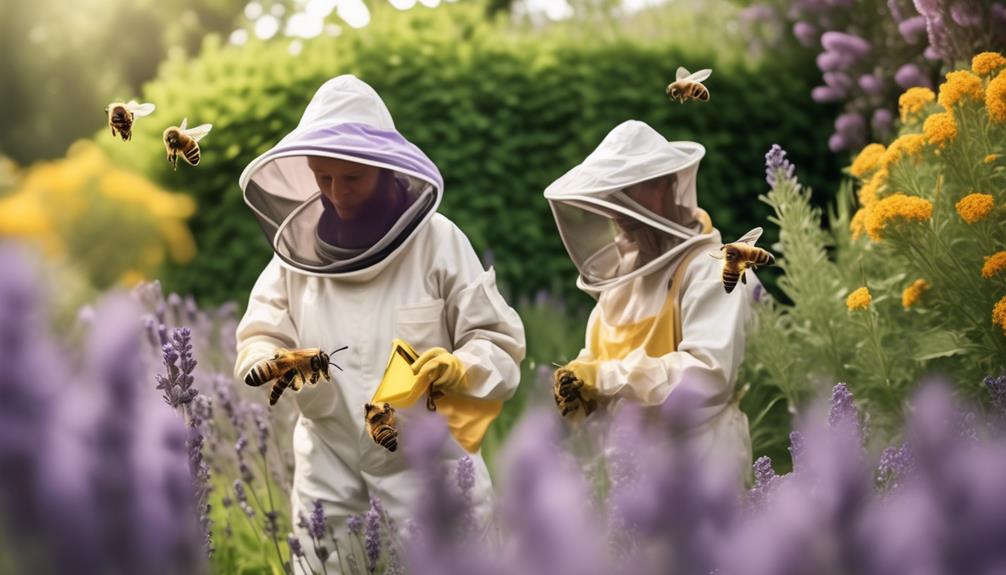
When it comes to calming bees without using smoke, certain essential tools and techniques can make the process smoother and more effective.
Firstly, consider a sugar spray. A simple solution of water and sugar can simulate nectar and distract the bees, making them less aggressive. Ensure to spray it gently, without causing panic.
Secondly, a bee brush can be useful. It's a soft-bristled tool designed to gently move bees without harming them. It's especially useful when you need to inspect the hive or handle the bees directly.
Thirdly, don't overlook the importance of a good quality bee suit. Regardless of your calming technique, protective clothing is crucial. Choose a suit that offers full coverage, yet is breathable and comfortable.
Lastly, consider using essential oils like lemongrass or lavender. They've been known to have calming effects on bees. However, use these sparingly and conduct proper research as some oils can be harmful to bees.
Natural Bee Calming Techniques
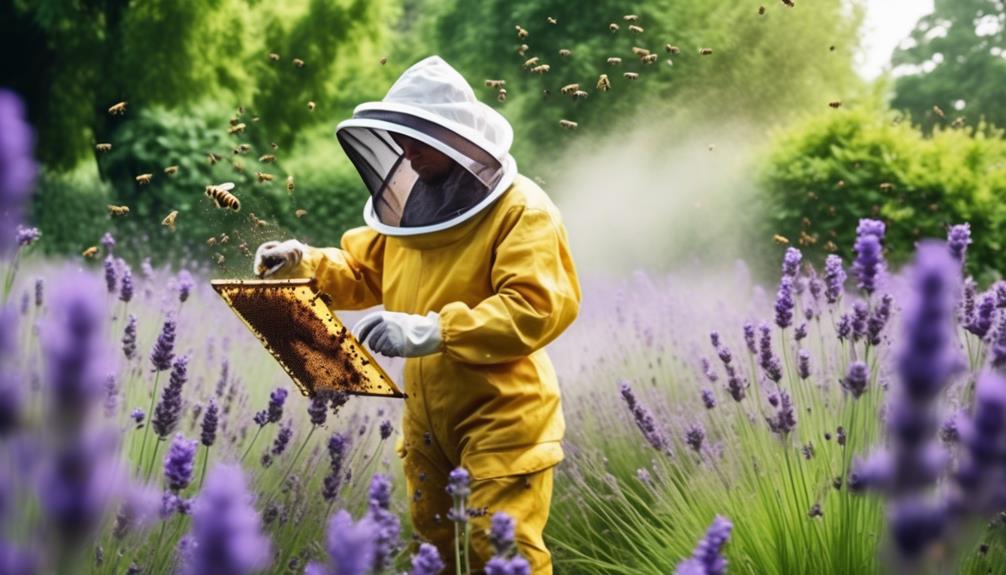
Building on the use of natural essentials like sugar sprays and oils, let's explore other natural methods to calm bees that are as effective, if not more.
Lemongrass oil is one such method. It's a strong attractant for bees due to its high citral and geraniol content, two compounds found in bee pheromones. By placing a few drops near the hive entrance, you can help keep your bees calm and focused on their tasks.
Another method is to use a natural bee lure. These lures contain pheromones that mimic the queen bee's scent, helping to maintain the hive's harmony. They're easily placed in or near the hive and can be purchased from beekeeping suppliers.
You could also try a technique called 'draping'. This involves placing a wet cloth over the hive, which can help the bees to feel secure and less likely to become agitated.
Lastly, remember that a calm beekeeper equals calm bees. Your movements should be slow and deliberate, to avoid alarming the bees.
These natural techniques aren't only safer for you and the bees, but they're also more environmentally friendly. So, give them a try next time you're tending to your hive.
Benefits of Smoke-Free Methods
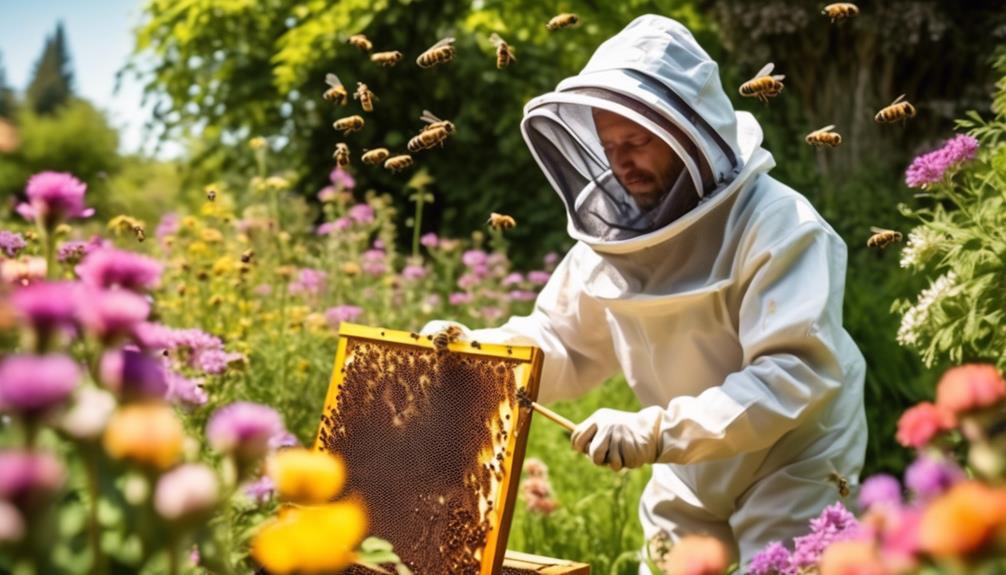
Smoke-free methods of calming bees offer a myriad of benefits you mightn't have considered. Firstly, the absence of smoke means there's no risk of residual contamination in your honey, ensuring a purer, tastier product. You'll also eliminate the risk of accidental fire which can be devastating.
Secondly, smoke-free techniques reduce stress on the bees. This can lead to a more productive hive, as happy bees are more efficient workers. By not smoking the bees, you're also preserving their natural behaviors and rhythms, which is vital for the overall health of the colony.
Lastly, smoke-free methods are more environmentally friendly. You're not contributing to air pollution, and you're reducing your carbon footprint. It's a small step towards a greener planet. Plus, these methods usually involve natural, renewable resources which are cheaper and readily available.
Safety Precautions and Tips
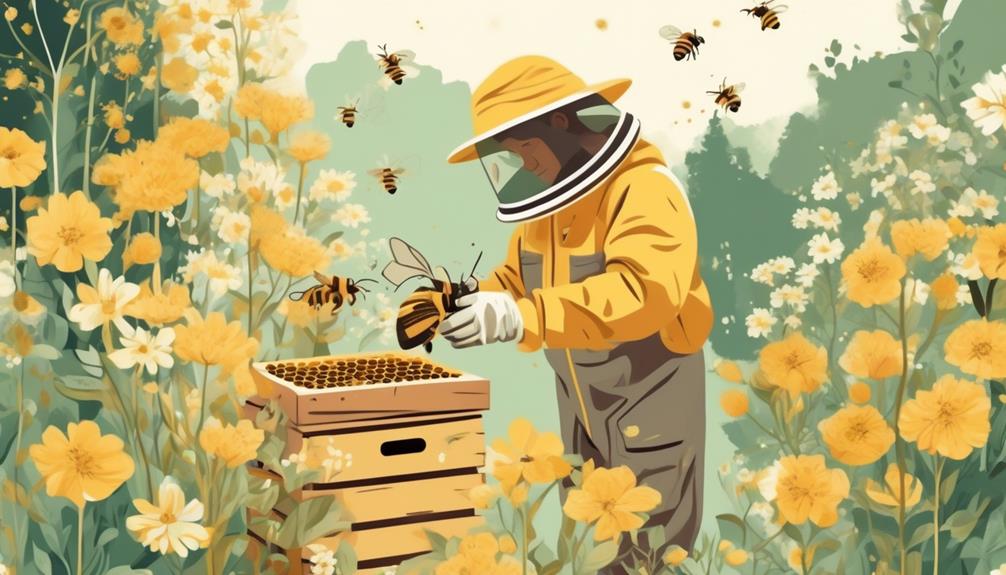
While it's clear that going smoke-free can benefit both your bees and the environment, it's crucial to practice safe handling techniques to ensure you and your hive remain unharmed. Always wear appropriate protective gear when working with your hive; a veil, gloves, and a beekeeper's suit can keep you safe from potential stings.
Next, remember that slow, deliberate movements are best. Quick or jerky movements can startle your bees, resulting in a defensive response. When using smoke-free calming methods, like sugar water, apply it gently and evenly across the hive.
To further minimize risk, avoid working with your bees during their active periods. Early morning or late evening, when bees are less active, is the optimal time for hive maintenance.
Lastly, maintain a healthy respect for these fascinating creatures. Be aware of their behavior and mood. If they seem agitated, it might be best to leave them be and return at a later time.
Frequently Asked Questions
What Are the Potential Health Risks for Bees That Are Exposed to Smoke?
When bees are exposed to smoke, they're at risk of respiratory distress and disorientation. It's like you being in a room full of smoke – it's hard to breathe, navigate, or function normally.
Plus, smoke can mask their pheromones, disrupting communication within the hive. Long-term exposure can even lead to premature death.
Can the Honey Produced by Bees Be Affected by Smoke?
Yes, smoke can potentially affect the honey produced by bees. When you expose bees to smoke, they consume more honey, which can alter its composition.
Smoke can also leave a residue in the hive that may impact the taste of the honey.
It's best for the bees, and the quality of your honey, to use smoke-free methods when working with your hive.
How Do Smoke-Free Methods Impact the Productivity of a Bee Colony?
Smoke-free methods can positively impact your bee colony's productivity. When you use alternatives like sugar water, it's less stressful for the bees, keeping them calmer and healthier. This results in increased honey production.
However, it's crucial you're gentle and slow while handling the hive, as sudden movements can agitate them. So, it's not just about ditching smoke, but also adopting a mindful approach to beekeeping.
Are There Specific Species of Bees That Respond Better to Smoke-Free Calming Techniques?
Yes, there are specific bee species that respond better to smoke-free calming techniques. For instance, honey bees react well to gentle vibrations and low light.
Bumblebees, on the other hand, become calmer when exposed to certain pheromones.
It's important to research your specific bee species to ensure you're using the most effective, stress-free calming method.
It's also vital to observe their behavior regularly to understand their unique needs and responses.
What Are the Long-Term Effects of Using Smoke-Free Methods on Bee Populations?
You're asking about the long-term effects of smoke-free methods on bee populations. Using such methods, you're likely to see healthier bees in the long-run. Smoke can stress bees, potentially weakening their immune systems.
With smoke-free techniques, bees aren't exposed to these negative effects. Their environment remains cleaner, their food sources aren't contaminated, and overall, the hive's health and productivity may improve.
It's a win-win for both bees and beekeepers.
Conclusion
Understanding bee behavior and employing natural calming techniques can make your beekeeping experience safer and more enjoyable.
Smoke-free methods offer significant benefits, reducing stress on bees and keeping your environment cleaner.
Always remember to use proper safety precautions though.
Ultimately, being gentle, patient, and respectful towards the bees is the best way to ensure a calm, productive hive.
With practice, you'll master the art of calming bees without smoke.

